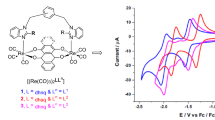Abstract
The complex trans-[RuPy4(CN)2] cleaves chloride bridges in the binuclear rhodium(i) and palladium(ii) complexes [Rh(CO)2Cl]2, [Rh(η4-C8H12)Cl]2, [(η4-C8H12)Rh(μ-Cl)2Rh(CO)2], [Pd(η3-C3H5)Cl]2, and [(η3-C3H5)Pd(μ-Cl)2Rh(CO)2] to form heterometallic triad complexes [(CO)2ClRh(NC)RuPy4(CN)RhCl(CO)2] (1), [(η4-C8H12)ClRh(NC)RuPy4(CN)RhCl-(η4-C8H12)] (2), [(CO)2ClRh(NC)RuPy4(CN)RhCl(η4-C8H12)] (3), [(η3-C3H5)ClPd(NC)-Ru(Py)4(CN)PdCl(η3-C3H5)] (4), and [(CO)2ClRh(NC)Ru(Py)4(CN)PdCl(η3-C3H5)] (5), respectively. In solutions, complex 3 coexists with equilibrium amounts of compounds 1 and 2; complex 5 is in the equilibrium with compounds 4 and 1. In both cases, the ratio of concentrations is close to binomial. Complexes 2 and 5 treated with [Rh(CO)2Cl]2 are converted into 1 with the simultaneous formation of [Rh(η4-C8H12)Cl]2 and [Pd(η3-C3H5)Cl]2, respectively. The δH and δC values for the ligands η4-C8H12, η3-C3H5, and CO are sensitive to the nature of the remote triad unit. The ligand effects are shown to be transmitted along the chain L′-M′-(NC)-Ru-(CN)-M″-L″.
Similar content being viewed by others
References
A. J. Deeming, G. P. Proud, H. M. Dawes, M. B. Hursthouse, Polyhedron, 1988, 7, 651.
H. Vahrenkamp, A. Gey, G.N. Richardson, J. Chem. Soc., Dalton Trans., 1997, 3643.
Z. N. Chen, R. Appelt, H. Vahrenkamp, Inorg. Chim. Acta, 2000, 309, 65.
R. Appelt, H. Vahrenkamp, Inorg. Chim. Acta, 2003, 350, 387.
S. P. R. Almeida, M. Fátima, C. Guedes da Silva, L. B. Jerzykiewicz, P. Sobota, A. J. L. Pombeiro, Inorg. Chim. Acta, 2003, 356, 259.
T. Sheng, H. Vahrenkamp, Inorg. Chim. Acta, 2004, 20, 1739.
M.-L. Flay, H. Vahrenkamp, Z. Anorg. Allg. Chem., 2004, 630, 2508.
A. Rodriguez-Dieguez, J. Cano, F. Lloret, V. McKee, H. Stoeckli-Evans, E. Colacio, Inorg. Chem., 2006, 45, 10537.
Yu. S. Varshavsky, T. G. Cherkasova, A. B. Nikol’skii, V. N. Khrustalev, I. S. Podkorytov, XVIII Mezhdunarodnaya Chernyaevskaya konferentsiya po khimii, analitike i tekhnologii platinovykh metallov [VIII Int. Chernyaev Conf. on Chemistry, Analysis, and Technology of Platinum Metals] (Moscow, October 10–13, 2006), Moscow, 2006, p. 145 (in Russian).
Yu. S. Varshavsky, T. G. Cherkasova, I. S. Podkorytov, A. B. Nikol’skii, XXIII Mezhdunarodnaya Chugaevskaya konferentsiya po koordinatsionnoi khimii [XIII Int. Chugaev Conf. on Coordination Chemistry] (Odessa, September 4–7, 2007), Kiev, 2007, p. 330 (in Russian).
Y. Varshavsky, T. G. Cherkasova, M. R. Galding, I. S. Podkorytov, S. N. Smirnov, V. N. Khrustalev, A. B. Nikolskii, 38 Int. Conf. on Coordination Chemistry. Abstracts (Jerusalem, Israel, July 20–25, 2008), Jerusalem, 2008, 516.
Yu. S. Varshavsky, T. G. Cherkasova, M. R. Galding, V. N. Khrustalev, I. S. Podkorytov, V. A. Gindin, S. N. Smirnov, A. B. Nikol’skii, J. Organomet. Chem., 2009, 694, 2917.
Yu. S. Varshavsky, T. G. Cherkasova, M. R. Galding, V. N. Khrustalev, I. S. Podkorytov, V. A. Gindin, S. N. Smirnov, A. B. Nikol’skii, Global J. Inorg. Chem., 2010, 1, 1.
Yu. S. Varshavsky, Zh. Inorg. Khim., 1969, 14, 1122 [J. Inorg. Chem. USSR (Engl. Transl.), 1969, 14].
B. J. Coe, T. J. Meyer, P. S. White, Inorg. Chem., 1995, 34, 593, 3600.
L. M. Toma, L. D. Toma, F. S. Delgado, C. Ruiz-Pérez, J. Sletten, J. Cano, J. M. Clemente-Juan, F. Lloret, M. Julve, Coord. Chem. Rev., 2006, 250, 2176.
W. Imhof, K. HalBauer, H. Görls, Acta Crystallogr., 2005, E61, m2130.
T. G. Cherkasova, L. Osetrova, Yu. S. Varshsavsky, Rhodium Express, 1993, 1, 8.
T. G. Cherkasova, M. R. Galding, L. Osetrova, Yu. S. Varshavsky, Rhodium Express, 1994, 3, 17.
G. Tresoldi, P. Pirano, E. Rotondo, F. Faraone, J. Chem. Soc., Dalton Trans., 1991, 425.
Yu. S. Varshavsky, T. G. Cherkasova, L. S. Bresler, Koord. Khim., 1986, 12, 792 [J. Coord. Chem. USSR (Engl. Transl.), 1986, 12].
Author information
Authors and Affiliations
Corresponding author
Additional information
Published in Russian in Izvestiya Akademii Nauk. Seriya Khimicheskaya, No. 4, pp. 0810–0817, April, 2012.
Rights and permissions
About this article
Cite this article
Nikol’skii, A.B., Varshavsky, Y.S., Cherkasova, T.G. et al. Interfragment transmission of electronic effects of π-acceptor ligands in heterometallic triad complexes with trans-[Ru(Py)4(CN)2] as a central unit. Russ Chem Bull 61, 813–820 (2012). https://doi.org/10.1007/s11172-012-0113-7
Received:
Published:
Issue Date:
DOI: https://doi.org/10.1007/s11172-012-0113-7




